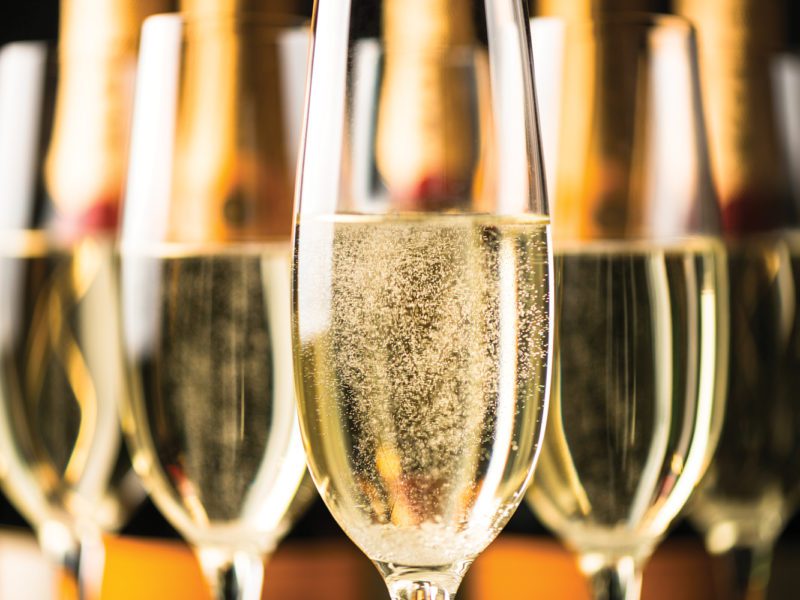
By Gary Twining
While the finest quality Champagne is generally acknowledged as the most elite, complex sparkler produced on the planet, there are many other “sparkling” options, available at a variety of prices, to please a variety of palates.
We cannot discount Charmat method (tank carbonated) sparklers such as Prosecco and the fruity, frothy Moscatos that offer great value, menu pairing versatility and drinkability. They do, most often, offer pleasant flavors rather than complexity. The Champagne method, or Méthode Champenoise (also known as Méthode Traditionnelle), requires secondary fermentation in the bottle. Aging on the yeast lees give more texture, richness, mouthfeel and longer finish to Champagne-method wines, making them highly sought after in all price ranges.
Following are some Méthode Champenoise sparklers to enjoy and investigate.
California – California is home to many of the French Champagne producers’ satellite operations. Consequently, The Golden State is also home to some exceptional domestic sparklers. Domaine Chandon, Mumm Napa, Taittinger’s Domaine Carneros, Piper Sonoma and Roederer Estate all have ties to French Champagne producers that have many years of sparkling wine production experience and knowledge.
Independent producers in California – including Paula Kornell, Korbel, Iron Horse, Schramsberg, Scharffenberger, Gloria Ferrer and Caraccioli Cellars – are making some lovely sparkling wines. Producers like Monticello Cellars for example, who are known for their still wines, also produce superb sparkling wines in allocated amounts.
France – All that sparkles is not Champagne, and the best Champagne method sparklers outside of the French Champagne district, are known as Crémant. Produced in Loire, Bordeaux, Limoux, Die, Savoie, Jura, Burgundy and Alsace, some Crémant offers close-to-Champagne complexity at a lower price. Grape varieties in the Cuvée vary based on what is grown in each region. More than fifty percent of the world’s Crémant production comes from Alsace, making Crémant d’Alsace easiest to find.
Italy – Franciacorta is a sparkling wine district in northern Italy’s Lombardy region. With history dating to the Middle Ages, and overwhelmingly organic viticulture, traditional Champagne grapes with allowable additions of Pinot Blanc, make elegant and stylish wines. Oltrepo Pavese, in south Lombardy, produces Champagne method sparklers from Pinot Noir grapes. The neighboring region of Trentino is famous for excellent bubbles, made to compete with Champagne. The Trentino region’s mountainous terrain impacts the flavor and type of fruit grown there. There are 57 producers making quality sparkling wine in the hills of Trentino.
Spain – Spain is one of the world’s largest producers of Champagne-method sparkling wines that vary in price and complexity. Cava is a designation for sparkling wines from Spain. While many Cava producers are using indigenous grapes like Macabeo, Parellada and Xarel-lo, Chardonnay is becoming a more common addition to Spanish wines to reduce earthiness. Spanish sparklers made from Pinot Noir and Chardonnay grapes, compete with true, French Champagnes.
Australia –Sparklers have been commercialized in Australia since the 1800’s. There are producers in cooler-climate regions that craft different styles of wines for all purposes. Many of the traditional method wines are made from Chardonnay, Pinot Noir and Pinot Meunier grapes, though Aussie uniqueness is expressed in red sparklers produced with Shiraz and Chambourcin grapes. (Try sweeter examples with chocolate desserts!)
South Africa – Wines in the Cap Classique category can be white, rosé, vintage or multi-vintage Champagne-method sparklers made with classic grapes.
England – With the recent trend of warmer vintages, the previously cold and rainy English shores are now producing some lovely sparklers. Greater availability pending. These wines can be quite nuanced, similar in style and elegance to French Champagne.
Germany – Seek wines labeled Sekt bestimmter Anbaugebiete or Qualitätsschaumwein b.A. (b.A. = from one of the thirteen quality regions). Look for estates making their own Sekt. Winzersekt means estate sparkling wine from a single varietal. (Champagne/Classic method = “Klassische Flaschengärung”).
Austria – In Austria look for Sekt labeled “Reserve” (aged on the lees for 18 months) and “Grosse Reserve” (aged on the lees for 30 months).
OHIO BUBBLES!
Below is a partial list. Visit Ohio wineries all over our great state to find bubbles from dry to sweet!
Ferrante Winery & Ristorante | Geneva
Henke Wine | Cincinnati
Kosicek Vineyards | Harpersfield
Laurello Vineyards | Geneva
M Cellars | Geneva
Meier’s Wine Cellars | Cincinnati
Ravenhurst Champagne Cellars | Mount Victory
Valley Vineyards | Morrow
Investigate the options and savor!

